
Garcia is a plant genus of the family Euphorbiaceae and of the monotypic subtribe Garciinae, first described as a genus in 1792. It is native to Central America, Mexico, Colombia, and Venezuela, and also naturalized in some of the West Indies.
- Garcia nutansVahl ex Rohr - Mexico from Sinaloa and San Luis Potosí to Chiapas + Yucatán, Central America, Colombia, Venezuela
- Garcia parvifloraLundell - Chiapas, Tabasco, Veracruz

Pseudophoenix is a genus of palms which is native to the wider Caribbean. Three species of the four species are endemic to Hispaniola, while the fourth, P. sargentii, is widely distributed in the northern Caribbean, Florida, and the Yucatán Peninsula.

Cameraria is a genus of plants in family Apocynaceae, first described for modern science by Linnaeus in 1753. It is native to southern Mexico, Central America, and the West Indies.

Brassia maculata, the spotted brassia, is a species of orchid. It is native to southern Mexico, Central America, Cuba, and Jamaica.
Spiracantha is a genus of flowering plants in the tribe Vernonieae within the family Asteraceae.
Plagiolophus is a genus of Mexican plants in the tribe Heliantheae within the family Asteraceae.

Androlepis skinneri is a plant species native to southern Mexico and Central America. This is one of the few Bromelioideae species that is dioecious.
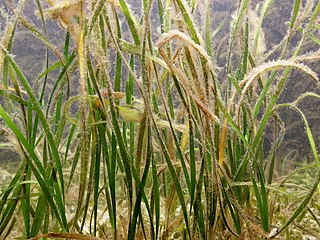
Halodule wrightii is an aquatic plant in the Cymodoceaceae family. It is referred to by the common names shoal grass or shoalweed, and is a plant species native to seacoasts of some of the warmer oceans of the world.
Iresine heterophylla, or Standley's bloodleaf, is a plant species native to the southwestern United States and also to Mexico. It has been collected from Arizona, New Mexico, Texas, Chihuahua, Sonora, Durango, Coahuila, Nuevo León, Campeche and Tabasco.
Spermacoce glabra, smooth false buttonweed, is a New World species of plants in the coffee family.

Borrichia arborescens is a species of flowering plant in the family Asteraceae known by the common name tree seaside tansy. It is native to the Yucatán Peninsula, Cuba, Jamaica, Bahamas, Cayman Islands, Hispaniola, Puerto Rico, Bermuda, the Florida Keys, and other islands in the region. It is found on rocky and sandy coasts, in both beaches and marshes.

Ionopsis utricularioides, the delicate violet orchid, is an epiphytic orchid native to the warmer parts of the Americas. It is reported from Florida, Mexico, Central America, much of the West Indies including the Cayman Islands, South America as far south as Paraguay, and the Galápagos.
Diastatea is a genus of plants native to Latin America, mostly in Mexico and Central America but with one species extending southward along the Andes to Argentina.
- Diastatea costaricensisMcVaugh - Guatemala, Honduras, Nicaragua, Costa Rica
- Diastatea expansaMcVaugh - central Mexico
- Diastatea ghiesbreghtii(Kuntze) E.Wimm - southwestern Mexico
- Diastatea micrantha(Kunth) McVaugh - widespread from central Mexico to the Jujuy region of northern Argentina
- Diastatea tenera(A.Gray) McVaugh - southern Mexico and Guatemala
- Diastatea virgataScheidw. - southern Mexico
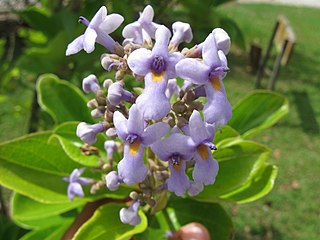
Cornutia is a genus of plants in the family Lamiaceae, first described in 1753. Species in this genus are native to tropical parts of the Western Hemisphere, including southern Mexico, Central America, the West Indies, and northern South America.
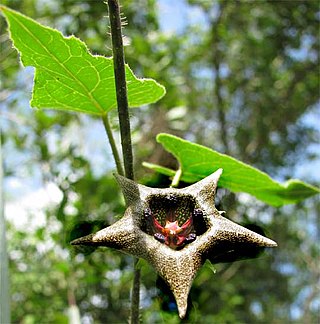
Dictyanthus is a genus of plant in family Apocynaceae, first described as a genus in 1844. It is native to Mexico and Central America.
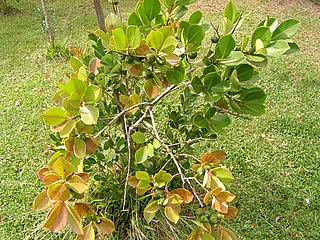
Mosiera is a genus of shrubs and small trees in the family Myrtaceae, first described as a genus in 1933. It is native to Mexico, Guatemala, the West Indies, Brazil, and Florida.
Brickellia kellermanii is a Mesoamerican species of flowering plants in the family Asteraceae. It is native to Central America and southern Mexico (Chiapas).

Cirsium horridulum, called bristly thistle, purple thistle, or yellow thistle is a North American species of plants in the tribe Cardueae within the family Asteraceae. It is an annual or biennial. The species is native to the eastern and southern United States from New England to Florida, Texas, and Oklahoma as well as to Mexico, Belize, Guatemala, Honduras, and the Bahamas.
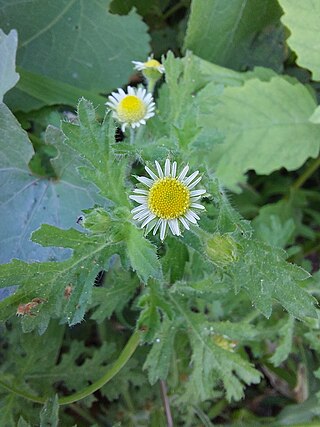
Egletes viscosa, the erect tropical daisy, is a New World species of flowering plant in the family Asteraceae. It is widespread across much of South America, Central America, Mexico, and the West Indies, just barely crossing the US border into the southernmost county in Texas.
Xyris ambigua, the coastal plain yelloweyed grass, is a North American species of flowering plant in the yellow-eyed-grass family. It is native to southern and eastern Mexico, Central America, Cuba, and the southeastern and south-central United States.












